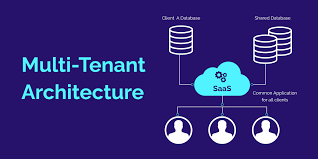Multi-Tenant Solutions
All in one Solution
What is it?
A multi-tenant web app serves multiple clients using one shared system. Tenants (clients) have their data, configurations, and users while sharing the app's infrastructure. Multi-tenancy excels in serving diverse clients, be they organizations, businesses, or individuals, by utilizing a shared infrastructure and a unified codebase.
Why does your business need a Multi-Tenant?
- Scalability: It is easier to scale a multi-tenant system to accommodate more tenants as your user base grows.
- Maintenance : Changes or bug fixes are instantly available to all users, reducing maintenance time and enhancing application availability.
Types Of Multi-Tenant Databases
- Shared Schema Multi-Tenant Database:
- In this model, all tenants share the same database schema, tables, and data structure.
- Each tenant's data is distinguished by a unique identifier or key within the shared schema.
- This approach is more efficient in terms of resource utilization but can be complex to manage in terms of data isolation and security.
- Efficient Resource Utilization: sharing the same database schema and structure among tenants optimizes resource usage, resulting in lower infrastructure and maintenance costs.
- Simplified Updates: When updates or changes are made to the shared schema, they are immediately available to all tenants, streamlining maintenance and ensuring consistency across the application.
- Separate Schema Multi-Tenant Database:
- Each tenant has its isolated schema within the same database instance.
- Tenants can have their tables, indexes, and stored procedures, providing better data isolation and customization.
- This model offers a balance between efficiency and tenant-specific customization.
- Enhanced Data Isolation: Each tenant has its isolated schema, which provides a higher level of data security and isolation, reducing the risk of data leaks or conflicts.
- Tenant-Specific Customization: Tenants can customize their schema, tables, indexes, and stored procedures to meet their specific needs, allowing for a higher degree of flexibility and customization while still sharing the same database instance for efficiency.
- Isolated Database Multi-Tenant Database:
- Each tenant has a completely separate and dedicated database instance.
- Tenants' data and resources are entirely isolated, ensuring the highest level of data security and customization.
- This approach may be less resource-efficient but offers the highest level of data separation and control.
Benefits:
Benefits:
How Does Multi-Tenant Work?

Multi-tenant architecture works by allowing multiple users or "tenants" to share a single instance of an application while keeping their data and configurations isolated from one another. This is achieved through various methods, such as shared databases, separate schemas, or isolated databases.
Who is the ideal user for Multi-Tenant?
- SaaS Providers
- Enterprise Businesses
- Small and Medium-sized Businesses (SMBs)
- Educational Institutions
- Healthcare Providers
- Real Estate Management
- E-commerce Platforms
- IoT Solution Providers
- Financial Services
- Government Organizations
- Nonprofit Organizations
DrapCode Multi-Tenant SaaS Builder
"DrapCode's multi-tenant solution provides strong user management capabilities to ensure personalized experiences and safeguard data."
DrapCode enables those without coding experience to easily create a multi-tenant SaaS app with no coding required. It offers pre-configured, isolated multi-tenant architecture for complete privacy and data security, allowing tenants to scale independently.
Effortless, Cost-Effective Scaling
DrapCode presents the twin advantages of simplicity and affordability, making it an ideal choice for maximizing your software as a service (SaaS) web application. The platform’s simple approach allows users to easily expand their applications with a convenient monthly payment plan. This eliminates the need for complicated and time-consuming manual work that often comes with a high price tag. The subscription-based model looks cost-effective, and gives users the flexibility to adapt their SaaS web applications according to evolving needs without any financial pressure This approach does not provide for the scaling process is not only convenient but allows your application to grow faster without compromising functionality or resources. By choosing DrapCode, businesses can turn their attention to enhancing their web applications, believing in this unique flexibility and economic advantage combined with the affordability of the platform and ease of use will not hinder the growth process enables organizations to easily navigate the challenges of scaling Ensure that these their SaaS web applications are optimized to meet the demands of a dynamic digital landscape And in particular, DrapCode simplifies the path to development, providing investment-friendly solutions to extend the capabilities of SaaS web applications.
Hassle-Free Maintenance
DrapCode is your comprehensive solution, effortlessly managing all maintenance tasks, eliminating performance concerns and providing a smooth working environment. By outsourcing these responsibilities to DrapCode, you not only save on costs but you also give yourself the freedom to focus solely on your core business goals. Our commitment to managing the platform with ease ensures your business is efficient, fast and tuned for growth, and empowers you to navigate the competitive landscape with confidence. With DrapCode, feel free to focus on what matters
Seamless Third-Party Integrations
Using a robust multi-tenant architecture, our platform offers great flexibility, empowering users to customize their experience to suit unique specifications. Seamless integration with external and third parties is achieved through advanced APIs, ensuring seamless communication and collaboration. This design not only increases flexibility but also provides a flexible and efficient system that can adapt to different business needs. Driven by innovation, our multi-tenant architecture promises a simple and personalized experience, setting the stage for unparalleled customization possibilities and perfect collaboration with external systems using state-of-the-art APIs with a platform designed for adaptability, connectivity and customization Advance unlimited your own functions.
Optimal Resource Allocation
Efficiently allocate resources without budget-consuming development, delivery, or support tasks. Adjust your plan as your user base evolves, with no upfront commitments required.